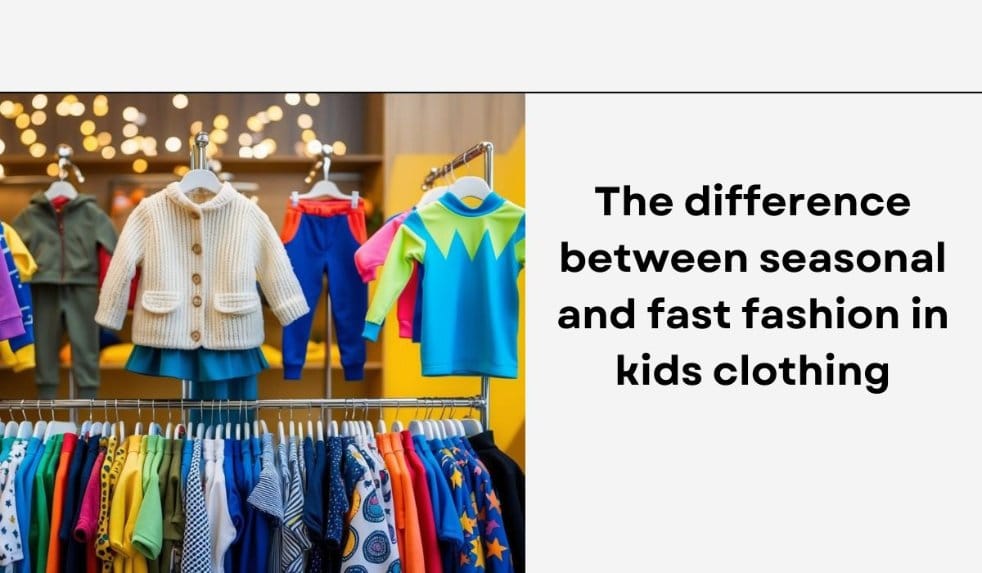Making Informed Choices Between Trend-Driven and Weather-Appropriate Children’s Fashion
Kids’ fashion changes quickly, with new styles appearing in shops all the time. There are two main types of fashion for children’s clothes: seasonal and fast fashion. Seasonal fashion follows the traditional fashion calendar, with new collections released twice a year for spring/summer and autumn/winter. Fast fashion, on the other hand, moves at a much quicker pace.
Fast fashion for kids involves producing cheap, trendy clothes very quickly to keep up with the latest styles. This type of fashion can lead to new items arriving in shops every few weeks. Zara, for example, releases new collections every two weeks. Seasonal fashion is more predictable and focuses on creating clothes suited to different weather conditions throughout the year.
The difference between these two approaches affects how kids’ clothes are made, sold, and worn. It also impacts how long the clothes last and how they affect the environment. Parents often have to choose between buying trendy, inexpensive items that might not last long, or investing in higher-quality seasonal pieces that can be worn for longer.
On This Page
Key Takeaways
- Seasonal fashion follows a twice-yearly calendar, while fast fashion produces new styles constantly
- Fast fashion offers trendy, cheap clothes, but seasonal fashion focuses on quality and durability
- The choice between seasonal and fast fashion affects cost, quality, and environmental impact of kids’ clothes
Defining Seasonal and Fast Fashion
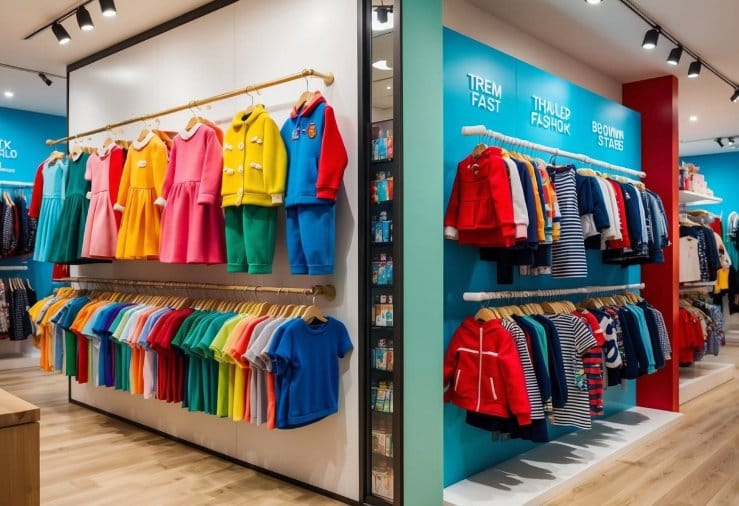
Seasonal and fast fashion represent two distinct approaches in the children’s clothing industry. They differ in their production cycles, design philosophies, and impacts on consumer behaviour.
Fashion Seasons Explained
Fashion seasons are set periods when new clothing collections are released. The traditional fashion calendar includes two main seasons: Spring/Summer and Autumn/Winter. These align with the changing weather and consumer needs throughout the year.
For children’s wear, seasonal fashion often includes:
- Spring/Summer: Light fabrics, bright colours, shorts, and sundresses
- Autumn/Winter: Warm materials, layered looks, coats, and boots
Some brands are moving towards a more flexible approach to seasons. They offer ‘trans-seasonal’ pieces that can be worn year-round, like versatile jackets or adjustable trousers.
Fast Fashion Overview
Fast fashion in children’s clothing refers to trendy, inexpensive items produced and consumed quickly. This model aims to bring the latest styles from catwalk to high street in record time.
Key features of fast fashion for kids include:
- Rapid production cycles
- Affordable prices
- Frequent new releases
- Trend-driven designs
Fast fashion companies may produce up to 52 ‘micro-seasons’ per year. This constant turnover encourages frequent purchases and can lead to overconsumption.
While fast fashion offers affordable, trendy options for growing children, it raises concerns about sustainability and quality. Parents must weigh the benefits of low-cost, fashionable clothes against environmental and ethical considerations.
The Fashion Calendar
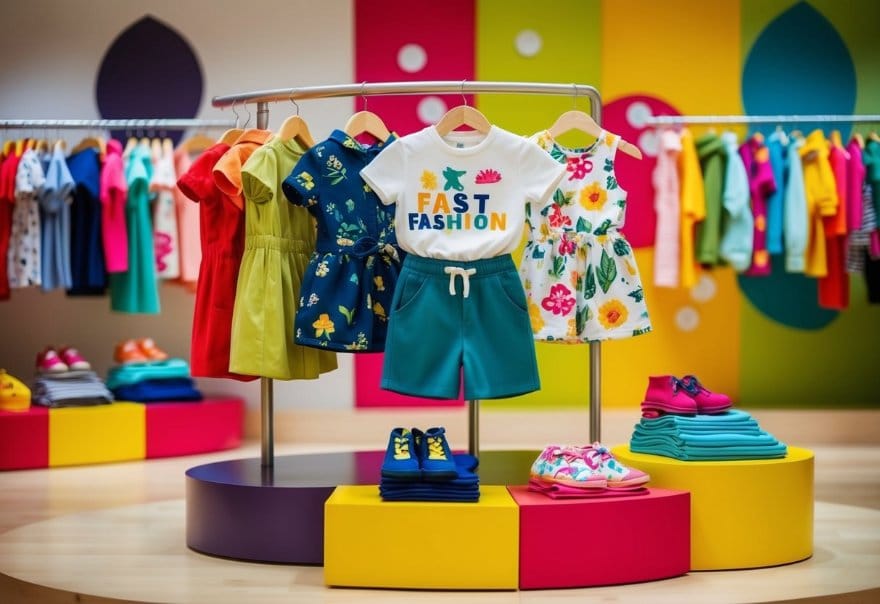
The fashion calendar guides the rhythm of the clothing industry. It sets key dates for new collections and shapes buying patterns for retailers and consumers alike.
Role of Fashion Weeks
Fashion weeks are crucial events in the fashion calendar. They showcase upcoming collections and set trends for the season ahead. The “Big Four” fashion weeks take place in New York, London, Milan, and Paris. These events happen twice a year, typically in February and September.
New York Fashion Week kicks off the season, followed by London, Milan, and Paris. Each city has its own flavour. New York is known for wearable fashion, while Paris often showcases haute couture. Buyers and press attend these events to spot trends and make purchasing decisions.
For children’s fashion, Pitti Bimbo in Florence is a key event. It happens in January and June each year.
Spring/Summer and Autumn/Winter Collections
The fashion world divides the year into two main seasons: Spring/Summer and Autumn/Winter. Spring/Summer collections are shown in September and October for the following year. Autumn/Winter collections are presented in February and March.
Spring/Summer clothing often features lighter fabrics and brighter colours. Autumn/Winter pieces tend to use heavier materials and darker hues. These collections set the tone for children’s fashion trends in the coming months.
Retailers typically start selling these collections a few months after the fashion shows. This allows time for production and shipping.
Pre-Fall and Resort Collections
Pre-Fall and Resort collections bridge the gap between the main seasons. Resort collections, also called Cruise collections, appear in stores around November and December. They often include holiday wear and pieces for warm-weather getaways.
Pre-Fall collections hit shops in May and June. They offer a preview of autumn trends and help retailers maintain customer interest between seasons.
These inter-seasonal collections are becoming increasingly important in children’s fashion. They provide fresh styles and help meet the demand for new products year-round.
Impact on Children’s Clothing
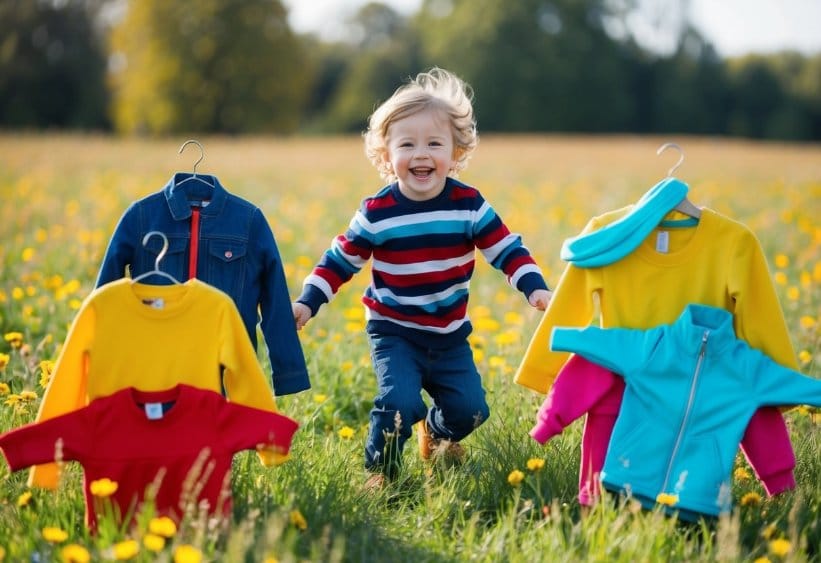
Seasonal and fast fashion trends shape children’s wardrobes in distinct ways. These approaches influence design choices, production methods, and shopping habits for kids’ clothes.
Designing for Kids’ Seasonal Fashion
Seasonal fashion for children aligns with the four main fashion seasons. Designers create collections that suit the weather and activities of each season. Spring brings light jackets and playful prints. Summer sees breezy shorts and sundresses. Autumn introduces cosy jumpers and jeans. Winter features warm coats and boots.
Seasonal designs often use higher quality fabrics. They aim to last through the entire season. Colours and styles reflect current trends but remain wearable for longer periods. This approach allows for more thoughtful design and production.
Fast Fashion Trends in Kids’ Wear
Fast fashion in children’s clothing moves at a rapid pace. New styles appear in shops every few weeks. This creates micro-seasons within traditional fashion seasons. Designs often copy celebrity kids’ outfits or popular cartoons.
Fast fashion brands produce cheaper clothes quickly. They use low-cost materials and labour. This leads to lower prices but also lower quality. Styles may only last a few wears before falling apart or going out of fashion.
The constant turnover encourages frequent shopping. Parents might buy new outfits for their kids more often. This can create a cycle of buying and discarding clothes quickly.
Sustainability and Ethical Considerations
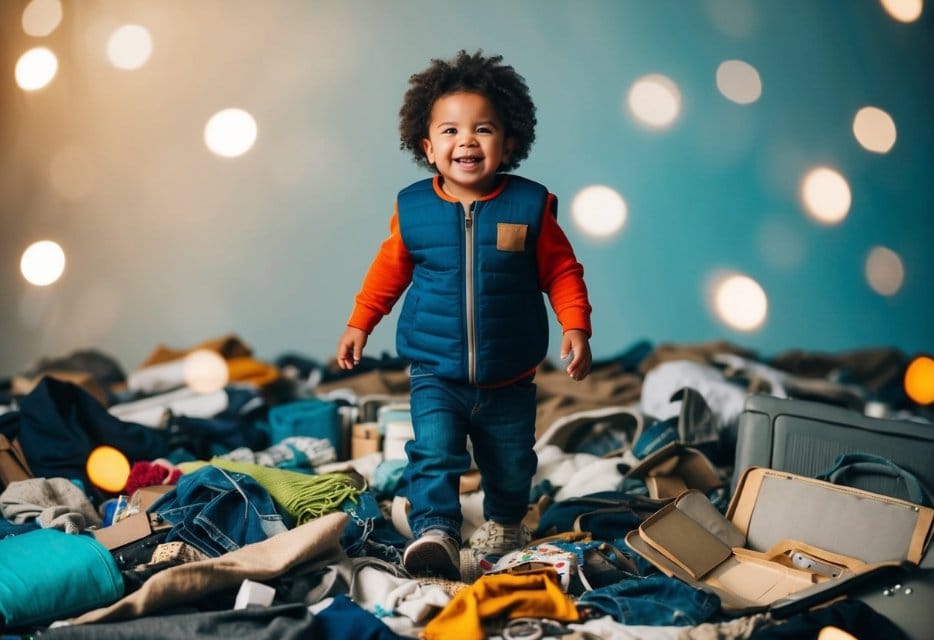
The fashion industry faces major challenges with sustainability and ethics, especially in children’s clothing. Fast fashion and seasonal trends have significant environmental and social impacts.
Environmental Impact of Fast Fashion
Fast fashion for kids creates massive waste. Clothes are often made from non-biodegradable materials like polyester, which end up in landfills. These synthetic fabrics shed microplastics when washed, polluting water sources.
Production of children’s fast fashion items uses harmful chemicals and dyes. This contaminates soil and water near factories. The industry also generates high greenhouse gas emissions from manufacturing and transport.
Constant new styles encourage parents to buy more, leading to overconsumption. Many garments are worn only a few times before being discarded.
Sustainable Fashion Practices
Sustainable kids’ fashion focuses on eco-friendly materials and production. Brands use organic fabrics like cotton, which are grown without pesticides. Some companies create clothes from recycled materials to reduce waste.
Durability is key in sustainable children’s wear. Well-made garments last longer and can be handed down or resold. This extends the life cycle of clothes and reduces the need for new purchases.
Conscious consumption is crucial. Parents are encouraged to buy less and choose quality over quantity. Renting or swapping kids’ clothes are growing trends that support sustainability.
Ethical brands ensure fair wages and safe working conditions in their supply chains. They avoid harmful chemicals, protecting both workers and children who wear the clothes.
Quality and Longevity
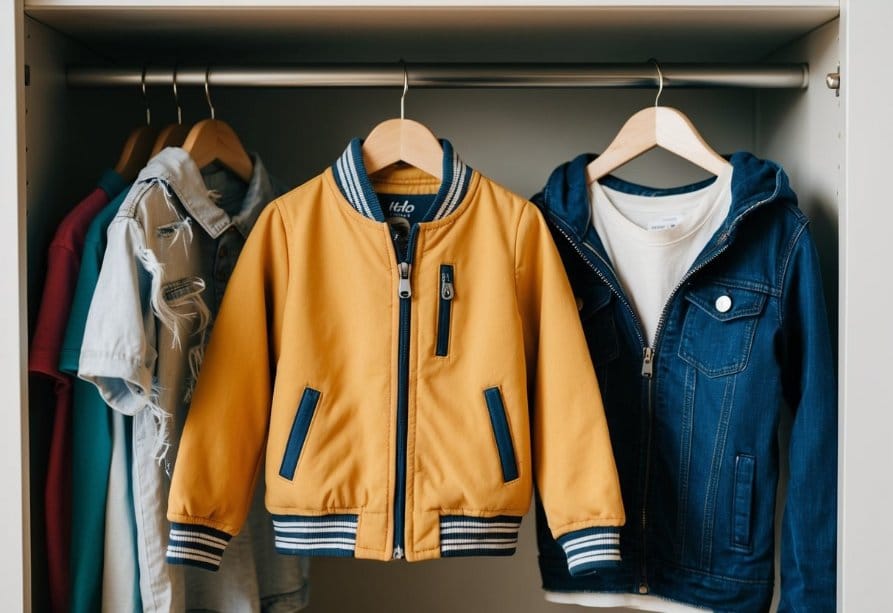
The difference between seasonal and fast fashion in children’s clothing is clear when examining quality and longevity. Better fabrics and classic designs often lead to longer-lasting garments.
Comparing Fabric Quality
Seasonal fashion typically uses higher-quality materials that withstand frequent washing and wear. These fabrics maintain their shape, colour, and texture over time.
Fast fashion, in contrast, often uses cheaper materials that may pill, fade, or lose shape quickly. This can lead to more frequent replacements and increased waste.
Natural fibres like cotton and wool are common in seasonal wear. They offer comfort and durability. Fast fashion tends to use synthetic blends that may not breathe as well or last as long.
Timeless Pieces vs. Trendy Items
Seasonal fashion focuses on timeless pieces that remain stylish year after year. These might include:
- Classic coats
- Simple jumpers
- Well-cut trousers
These items often feature neutral colours and versatile designs. They can be mixed and matched easily, extending their usefulness.
Fast fashion emphasises trendy items that may quickly go out of style. While exciting, these pieces often have a short lifespan in a child’s wardrobe.
Timeless pieces can be passed down to siblings or friends, reducing waste. Trendy items may be discarded more quickly, contributing to environmental concerns.
Adaptation to Climate and Seasonality
Seasonal clothing and fast fashion respond differently to climate and weather patterns. These approaches shape how children’s clothes are designed, produced, and sold throughout the year.
Seasonal Clothing for Varied Climates
Seasonal clothing for children adapts to different climates and weather conditions. Retailers stock cosy jumpers and coats for winter, while offering light dresses and shorts for summer.
Spring and autumn collections feature versatile layers like cardigans and light jackets. These items help kids stay comfortable as temperatures change. Some brands create region-specific lines to suit local climates.
Climate change affects seasonal clothing design. Unpredictable weather patterns lead to more adaptable pieces that work across seasons. This shift helps families get more use from clothes year-round.
Fast Fashion Responsiveness to Weather
Fast fashion brands react quickly to changing weather patterns. They can produce new styles in weeks, not months. This speed lets them offer trendy items that match current conditions.
If a heatwave hits, fast fashion shops quickly stock up on summery clothes. When it’s colder than expected, they rush out warm options. This flexibility helps meet sudden demand for weather-appropriate gear.
Fast fashion’s quick turnaround can lead to waste when weather doesn’t match predictions. Unsold items often end up discounted or disposed of. Some brands now use data to better forecast weather trends and reduce excess stock.
The Role of Fashion Designers and Brands
Fashion designers and brands shape the landscape of children’s clothing. They set trends, influence consumer choices, and drive the industry’s direction in both seasonal and fast fashion sectors.
Designers’ Influence on Seasonal Fashion
Fashion designers play a crucial role in seasonal collections for children’s wear. They create clothing lines that align with the four traditional fashion seasons: spring/summer, autumn/winter, resort, and pre-fall. These designers focus on quality, craftsmanship, and unique designs.
Seasonal fashion for kids often features:
- High-quality fabrics
- Innovative designs
- Limited quantities
- Higher price points
Designers draw inspiration from various sources, including art, culture, and current events. They aim to create garments that are both stylish and functional for children.
Fast Fashion Brands and Market Dynamics
Fast fashion brands have revolutionised the children’s clothing market. These companies produce trendy, affordable clothes at a rapid pace. They respond quickly to emerging styles and consumer demands.
Key aspects of fast fashion brands in kids’ clothing:
- Frequent collection updates (some release new items every two weeks)
- Lower prices
- Quick turnaround from design to retail
- Large-scale production
Fast fashion brands often replicate designer trends at lower costs. This approach makes fashionable children’s clothing more accessible to a wider range of consumers.
Looking Ahead: The Future of Kids’ Fashion
Kids’ fashion is evolving rapidly. New trends and approaches are reshaping how children’s clothing is designed, produced, and consumed. Let’s explore what’s on the horizon for kids’ fashion.
Predicting Upcoming Trends
The future of kids’ fashion is set to be more sustainable and tech-savvy. Eco-friendly materials like organic cotton and recycled fabrics will become more common. These choices are gentle on young skin and better for the planet.
Smart clothing with built-in technology may gain popularity. Think shirts that change colour or shoes that track activity levels. These innovations could make fashion both fun and functional for kids.
Cultural diversity will play a bigger role in designs. We’ll likely see more styles inspired by different global traditions and art forms. This shift will help create a more inclusive fashion landscape for children.
The Move Towards Seasonless Fashion
Seasonless fashion is gaining ground in kids’ wear. This approach moves away from the traditional fall/winter and spring/summer collections. Instead, it focuses on versatile pieces that work year-round.
The benefits of seasonless fashion are numerous:
- Less waste as clothes are worn for longer
- More value for money for parents
- Easier wardrobe planning for children
Stretchable fabrics and multifunctional designs are key to this trend. They allow clothes to adapt to different weather conditions and activities. A single item might take a child from the classroom to the playground, regardless of the season.
This shift could change how fashion cycles work for kids’ clothing. The obsolescence stage may become less pronounced as styles remain relevant for longer periods.
Frequently Asked Questions
Parents often wonder about the differences between seasonal and fast fashion for children’s clothing. These questions explore key distinctions in trends, sustainability, quality, and environmental impact.
How do seasonal fashion trends differ from fast fashion trends in children’s attire?
Seasonal fashion for kids follows the traditional spring/summer and autumn/winter collections. These trends change more slowly and often reflect broader themes.
Fast fashion trends for children’s wear change rapidly, sometimes weekly. They quickly copy catwalk styles and celebrity looks for quick production and sale.
Why is fast fashion considered less sustainable than seasonal fashion for children’s wear?
Fast fashion for kids produces large amounts of cheap clothing that often ends up in landfills. This leads to more waste and pollution.
Seasonal fashion tends to use better quality materials and construction. These clothes last longer and can be passed down or resold, reducing waste.
Can you explain the impact of fast fashion on the quality and durability of kids’ clothing?
Fast fashion items for children are often made with cheaper materials and quick production methods. This can result in clothes that wear out quickly or fall apart after a few washes.
Seasonal fashion typically uses higher quality fabrics and more careful manufacturing. These clothes tend to last longer and stay in good condition.
What defines slow fashion, and how does it compare to fast fashion in the context of children’s garments?
Slow fashion for kids focuses on timeless styles, quality materials, and ethical production. It aims to create clothing that lasts and can be worn for multiple seasons.
Fast fashion prioritises quick production and low costs. It creates trendy items that may only be worn for a short time before being replaced.
What are the environmental implications of choosing fast fashion for kids instead of seasonal collections?
Fast fashion for children uses more resources and creates more pollution. It often involves harmful chemicals and generates a lot of textile waste.
Seasonal collections tend to have a smaller environmental impact. They use fewer resources and create less waste due to better quality and longer-lasting designs.
In terms of kids’ apparel, what are the characteristics that distinguish traditional fashion from fast fashion?
Traditional fashion for children focuses on classic styles and quality. It often uses natural materials and puts more emphasis on durability and comfort.
Fast fashion for kids prioritises current trends and low prices. It typically uses synthetic materials and focuses on quick production and sale.
Related Post: How Often Should You Buy Kids’ Clothes?

